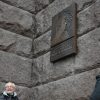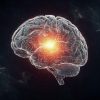
Peter Scott-Morgan stands, wide-eyed and tearful. “Good. Grief.” he says quietly. “I was unprepared for the emotion… It’s quite extraordinary. It really is.”
Using an exoskeleton, Dr Scott-Morgan is experiencing what it is like to stand for the first time in months after being diagnosed with Motor Neurone Disease (MND) in 2017, the same incurable condition that killed scientist Stephen Hawking.
The remarkable step, however, is just the first in the 62 year old’s bold journey to control his disease by becoming the world’s first, fully-fledged cyborg.
“Think of it as a science experiment,” he laughs. “This is cyborg territory, and I intend to be a human guinea pig to see just how far we can turn science fiction into reality.”
Eventually, Dr Scott-Morgan wants the exoskeleton to encase his upper-body, giving him superhuman strength and the ability to tower above “flesh and blood” humans. A mind-reading computer will be plugged directly into his brain, expressing his thoughts almost instantly. Meanwhile, his paralysed face will be replaced by a hyper realistic avatar that will move in time with a speech synthethiser.
“In a rather perverse way the future looks like it’s going to be rather exciting,” writes Dr Scott-Morgan on his blog, with his characteristic optimism. “In a ‘boys with their toys’ sort of a way, potentially even a little bit fun.”
His inspiring mission has become the subject of a documentary by Cardiff Productions, ‘Peter: The Human Cyborg’, which is due to be aired on Channel 4 on August 26th. Filmed over two-years, the scientist from Torquay in South Devon takes viewers on a deeply-personal quest to find the technologies and people that can help him become part-robot, part-machine.

An early version of Dr Scott-Morgan's hyper realistic avatar, which will eventually be placed in front of his face
Credit: Cardiff Productions
With a master’s in artificial intelligence and a PhD in robotics, Dr Scott-Morgan hopes to find a better way for people with MND to live once they become “locked-in”, suffering with a mind that is fully alert but a body that is unable to move.
“You feel very afraid watching him deteriorate,” says Francis, his husband and partner of 40 years in one particularly emotional scene. “It’s traumatic.”
Dr Scott-Morgan says he isn’t deteriorating but becoming a new version of himself — one that will eventually pave the way for a breed of humans that can augment their capabilities using technology.
He’s already made some radical changes to his body. In 2018, he ‘re-plumbed’ his stomach so that he would no longer have to rely on a carer to eat or go to the bathroom.
That required a tripleoscopy; three separate high-risk surgeries to insert a feeding tube in his stomach, a catheter into his bladder and a colostomy bag directly on to his colon. With each procedure, he risked accelerating the progress of MND

Dr Scott-Morgan says he isn’t deteriorating but becoming a new version of himself
Credit: Cardiff Productions
“You can’t help but be impressed by the way he wants to take control,” says Marie Wright, his anesthesiologist. “I think this is ground-breaking and he is a pioneer.”
Last year, he decided to undergo a laryngectomy to separate his oesophagus and trachea. The idea was to prevent saliva from running into his lungs as the paralysis moved up his body towards his chest and throat. The problem was, it would mean losing his distinctive voice, and with it, his ability to fully connect with those he loved.
“When I email people who are locked in, they say of all the faculties that they lost, speech was the worst, the most traumatic, the one that made them feel most disabled,” he says. “It is impossible, even if they use text-to-speech… they are not able to communicate their emotion.”
It’s the fate Dr Scott-Morgan fears the most, and the one that he’s spent time trying to address. Prior to losing his voice, he spent hours recording words and sentences with the help of scientists at Edinburgh-based Cereproc. These recordings have been used to create a synthetic voice that sounds almost like the original.
Alongside this, a photo-realistic virtual avatar has been designed that moves its lips in time with his speech, providing facial expressions, such as laughter and surprise, in time with the conversation.
But that isn’t quite enough for the cyborg pioneer. To help preserve his charismatic personality, Dr Scott-Morgan has enlisted the help of Lama Nachman, director of Anticipatory Computing at Intel Labs and the woman who helped re-build Professor Hawking’s speech system.
Over several months, the pair have developed a radical plan to give Dr Scott-Morgan’s cyborg its own artificial intelligence (AI).
Instead of answering a question by laboriously typing out individual letter, like Professor Hawking, he will rely on gaze tracking and the word prediction capabilities of AI to provide a full and instant response. Eventually, the machine will speak for itself using phrases it has learnt from Dr Scott-Morgan, crossing a controversial line in what it means to be human.
There is, however, a major problem: how to prevent the AI from taking control.
“It’s problematic, Peter will always have the pressure of picking a phrase the AI recommends rather than constructing his own speech. It’s simply quicker” says Ms Nachman. “Ethically, you have to be concerned about this.”

Dr Scott-Morgan has already undergone several high-risk surgeries to become a cyborg
Credit: Cardiff Productions
The team at Intel is now trying to create a way for Dr Scott-Morgan to teach the AI by flagging when a phrase is not quite what he had in mind. Over time, the AI will become more intelligent, merging its “personality” with Dr Scott-Morgan’s.
For now, his plans to connect his speech-system to a mind-reaching machine remain outside the realms of possibility. But Ms Nachman doesn’t rule it out in the future. “I can imagine a time when it’s used,” she says.
Other technologies to make his cyborg vision a reality, such as a self-driving exoskeleton, aren’t quite ready yet. He’s also decided to place his virtual avatar on a screen attached to his breastplate rather than covering his face.
But someday, the scientist hopes he can exist completely outside his physical body, with his personality, traits and knowledge downloaded onto a machine.

Dr Scott-Morgan with his husband Francis at their home in South Devon
Credit: Cardiff Productions
What’s striking about Dr Scott-Morgan is not just his constant optimism and bravery, but his ability to find radical answers to problems that have confounded Britain’s brightest minds.
“Growing up openly gay in the seventies taught me to think for yourself,” he says. “I got very used to not feeling that I had to fit, because for a long time the world was telling me you really, really didn’t fit. After 40 years of breaking the rules, I’m still saying let’s not do it the way it’s done before, let’s do something different.”
He has complete faith in technology to change how humans live, and is now campaigning, alongside his husband, for the “Right to Thrive”, calling on MPs to give individuals suffering from MND equal access to innovative technologies that will help them live. In the coming years, many bleeding-edge technologies that have been developed for Dr Scott-Morgan will become open-source, allowing others to benefit and improve the research for decades to come.
But his journey is far from over. “I am increasingly turning into a full cyborg and more AI will simply make me even more of a cyborg,” he says. “I will never stop being human, but maybe I will help to change what it means to be human. It’s a hugely exciting time to be alive.”
Peter: The Human Cyborg will air at 9pm, 26th August on Channel 4






















































Свежие комментарии